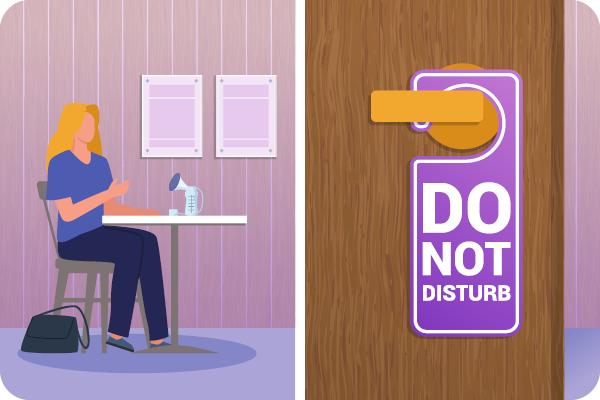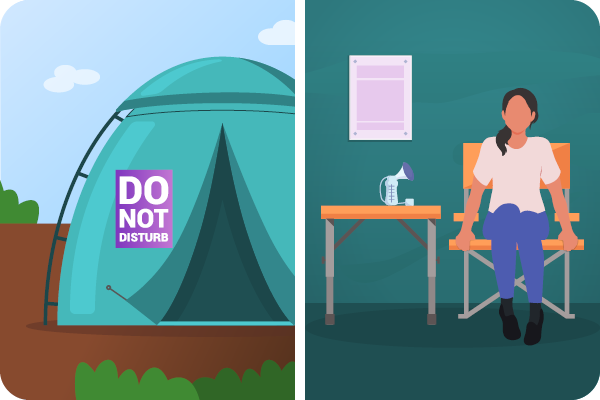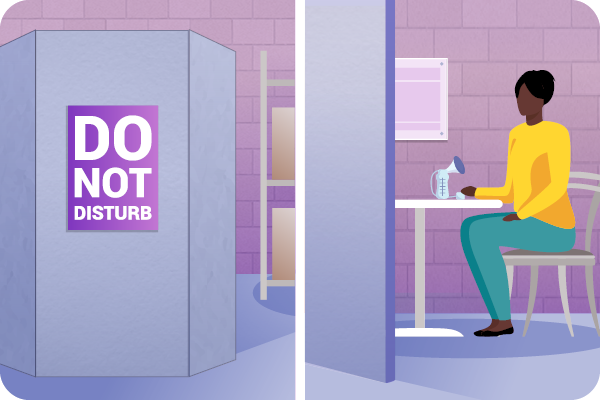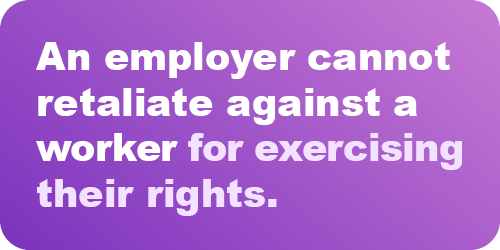
Under the Fair Labor Standards Act (FLSA), most nursing employees have the right to reasonable break time and a place, other than a bathroom, that is shielded from view to express breast milk while at work. This right is available for up to one year after the child's birth.
This guide provides employers with information on the FLSA's protections for nursing employees, including updates from the PUMP Act effective Dec. 29, 2022.
Nearly all employees covered by the FLSA are entitled to reasonable break time and space to pump at work for one year after their child's birth. Narrow exceptions may apply for certain employees of small companies and certain transportation workers (explained in the "Specific exemptions and delays" section of this guide).
There are two ways in which an employee can be covered by the FLSA: 'enterprise coverage' and 'individual coverage'.
All employees of an enterprise are covered under the FLSA if the employer is:
Individual employees may be covered and entitled to FLSA protections to pump at work if they are engaged in interstate commerce or the production of goods for interstate commerce even if the employer is not a covered enterprise.
Interstate commerce includes making out-of-state phone calls, receiving or sending interstate mail or electronic communications, ordering or receiving goods from out-of-state suppliers, handling credit card transactions, and performing accounting or bookkeeping for such activities.
Domestic service workers — such as housekeepers, full-time babysitters and cooks — are normally covered by the law.
Julia cleans guest rooms at hotels on weekends. Julia is entitled to break time and space under the FLSA for one year after the birth of a child.
Sam is a registered nurse who is exempt from receiving overtime pay under the FLSA. Beginning on December 29, 2022, Sam is entitled to break time and space for one year after the birth of a child.
Irina is the assistant manager at a fast-food restaurant with several locations and meets all requirements to be exempt from overtime pay requirements under the FLSA. When Irina returns to work after the birth of her child in March of 2023, to comply with the law, her employer provides an office to take four breaks a day of 25 minutes each to pump breast milk for the nursing child.
Nursing employees must receive:
The frequency and length of breaks needed to pump at work will likely vary.
As with other breaks under the FLSA, the nursing employee must be completely relieved from duty, or the time spent pumping must be counted as hours worked for the purposes of minimum wage and overtime requirements.
If an employer already provides paid break time and if an employee chooses to use that time to pump, they must be compensated in the same way that other employees are compensated for break time.
An employer must also pay for pump breaks if required by federal or state law or municipal ordinance. For more information, view Field Assistance Bulletin No. 2023-02: Enforcement of Protections for Employees to Pump Breast Milk at Work.
Madison works on a farm. Madison's employer provides all employees with two paid 15-minute rest breaks each day. Madison chooses to use both paid 15-minute breaks to pump breast milk for her 6-month-old infant. If Madison needs additional breaks to pump, the additional break time does not have to be compensated if Madison does not perform any work during the breaks.
Peyton is a third-grade teacher. Under the FLSA, Peyton is entitled to time to pump breast milk in a private space. Peyton chooses to grade papers and complete student records while pumping breast milk. Peyton must be compensated for the time spent pumping and doing this work at the same time.
The space for pumping must be:
Employers must ensure the employee's privacy, for example, by displaying a sign when the space is in use or providing a lock on the door.
Workers who telework must also be free from observation by any employer-provided or required video system, including a computer camera, security camera or web conferencing platform.
The designated area must function as a suitable space for pumping breast milk.
An employer may temporarily designate a space or make a space available when needed by the employee.
Employers should take into consideration the number of nursing employees and their work and pump schedules to determine whether more than one space should be designated or created.

Merin, a logging company employee, uses a shielded office break room for pumping, with the door locked for privacy. Protections to pump at work -- door hanger (PDF)

Yesenia, a farmworker, uses a temporary pumping space created by her employer in a pop-up tent. The tent is large enough for a chair and a table for the pump, and tall enough for her to stand up in.

Paige, a restaurant server, uses a temporary pumping space created by her employer in a storage room. They set up dividers and signs, allowing her to block or turn off cameras. The space also includes a chair and table.
Employers with fewer than 50 employees are relieved from their obligation to provide reasonable break time and space only if they can demonstrate that it would impose undue hardship in the particular circumstances. Whether compliance would be an undue hardship is determined on an individual employee basis.
The FLSA's pump at work protections generally apply to employees of rail carriers or motorcoach services operators as of Dec. 29, 2022. However, coverage for certain employees of rail carriers and motorcoach services operators begins Dec. 29, 2025. These employees include:
Once pump at work protections apply to these employees on Dec. 29, 2025, an exception to these protections may apply if an employer demonstrates that compliance requires significant expense or results in unsafe conditions.
Significant expense does not include installing a curtain or other screening protection.
The FLSA's pump at work protections do not preempt a state law or municipal ordinance that provides greater protections to employees than those provided by the FLSA. Many states have laws related to pumping milk at work.
Employers should know that several federal laws may apply and provide different employment protections at the same time to workers who are pregnant, have recently given birth and/or are nursing. For example, the Equal Employment Opportunity Commission administers related laws, including the Pregnant Workers Fairness Act, which provide protections to these workers.

It is also a violation of the FLSA to "discharge or in any other manner discriminate against" any employee because, for instance, they filed a complaint to assert their pump at work rights or cooperated in an investigation regarding these protections.
Employees are protected against retaliation regardless of whether the complaint is made orally or in writing.
Most courts have ruled that internal complaints to an employer are also protected under the FLSA's prohibition on retaliation.
Leslie is a delivery truck driver for a department store and takes breaks to pump breast milk twice a day. The supervisor complains that the breaks are interfering with the delivery schedule and moves Leslie to a lower-paying job as a result.
In this example, Leslie has experienced unlawful retaliation under the FLSA.
Violations of the FLSA pump at work protections can result in legal and equitable remedies for affected employees.
Remedies for violations of the reasonable break time and space requirements may include:
These legal and equitable remedies are also available for violations of the FLSA's prohibition on retaliation.
To enforce the pump at work or retaliation provisions of the FLSA, employees can file a complaint with WHD or file a private cause of action seeking appropriate remedies. Special notification procedures may be required for filing a private action if an employer has failed to provide an employee with an appropriate space to pump.
Before an employee can file a private suit regarding an employer's failure to provide a space to pump, the employee must notify the employer of the failure and allow 10 days for the employer to come into compliance.
The employee is not required to provide this notice:
These notification procedures do not apply when an employee or other party files a complaint with WHD about violations of any pump at work protections or brings a private suit to enforce the reasonable break time requirement.
Call our toll-free helpline at 1-866-487-9243 or visit dol.gov/agencies/whd/contact.